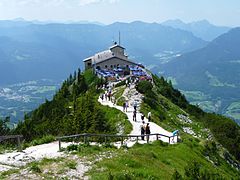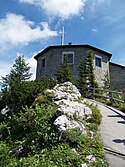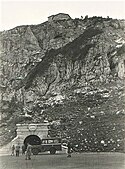Herbaciarnia na Kehlsteinie
| ||
(c) I, Ondřej Žváček, CC BY 2.5 | ||
| Państwo | ||
|---|---|---|
| Kraj związkowy | ||
| Miejscowość | Berchtesgaden | |
| Typ budynku | herbaciarnia | |
| Architekt | Roderich Fick | |
| Inwestor | Adolf-Hitler-Spende der deutschen Wirtschaft | |
| Rozpoczęcie budowy | 1937 | |
| Ukończenie budowy | 1938 | |
| Pierwszy właściciel | Adolf Hitler | |
| Strona internetowa | ||
Herbaciarnia na Kehlsteinie (niem. Kehlsteinhaus, ang. Eagle’s Nest – Orle Gniazdo) – herbaciarnia na szczycie góry Kehlstein w niemieckich Alpach, otwarta w 1938 roku. Była ona prezentem urodzinowym od NSDAP dla Adolfa Hitlera z okazji jego 50. urodzin.
Historia
Obiekt został wybudowany jako jedno z założeń kompleksu rezydencji Hitlera, Martina Bormanna, Hermanna Göringa i ich zaplecza, wznoszonych od 1933 roku do końca II wojny światowej ze środków tzw. Fundacji Hitlera w rejonie Berchtesgaden.
Miejsce budowy – zachodni skraj grzbietu Kehlstein górującego w prawo nad Berghofem i willowo–schroniskowy styl budynku – wybrał osobiście Bormann. Do obiektu prowadzi specjalnie w tym celu wybudowana, kręta, wąska asfaltowa szosa Kehlsteinstraße o długości 6,5 kilometra zakończona parkingiem na wysokości 1710 m n.p.m. Z parkingu, po przejściu 126 metrów w skalnej sztolni, dochodzi się do wykończonej w mosiądzach windy, którą po pokonaniu 124 metrów dojeżdża się na wysokość 1834 m n.p.m. bezpośrednio do willi. Cała inwestycja trwała 13 miesięcy i pochłonęła 30 milionów reichsmarek.
Hitler był w herbaciarni nie więcej niż dziesięć razy, w większości przy okazji wizyt zagranicznych gości, jakie przyjmował w Berghofie. Każdorazowy pobyt nie przekraczał 30 minut, co Hitler tłumaczył złym samopoczuciem na tej wysokości.
W czasie wojny obiekt nie uległ żadnym zniszczeniom i został zdobyty bez jednego wystrzału. Co do zdobywców obiektu źródła nie są jednomyślne i wskazują na żołnierzy amerykańskich z dwóch różnych jednostek:
Do budynku dotarli także Francuzi z 2 Dywizji Pancernej, którzy 4 maja zdobyli Berghof. Następnego dnia wywiesili oni swoją flagę narodową na Obersalzbergu[1].
Po wojnie, do 1960 roku, obiekt był używany przez aliantów zachodnich jako placówka telekomunikacyjna, a po tej dacie zwrócony władzom Bawarii. Aktualnie wykorzystywany jest jako restauracja i historyczne centrum informacyjne.
Galeria
Przypisy
- ↑ Victoire à Berchtesgaden - L'Express, www.lexpress.fr [dostęp 2020-08-27] (fr.).
Linki zewnętrzne
- Oficjalna strona Kehlsteinhausu (niem.)
- Kehlsteinhaus – Przewodnik (ang.)
Media użyte na tej stronie
Autor: Hanhil based upon previous work by TUBS, Licencja: CC BY-SA 3.0
Location map Bavaria, showing position of Bavaria within Germany. Geographic limits of the map:
Autor: NordNordWest, Licencja: CC BY-SA 3.0
Location map of Germany (Wp article: en:Germany)
Autor: Dennis Jarvis from Halifax, Canada, Licencja: CC BY-SA 2.0
PLEASE, NO invitations or self promotions, THEY WILL BE DELETED. My photos are FREE to use, just give me credit and it would be nice if you let me know, thanks.
Down a few steps from the dining room is another large stone-walled room that was used for conferences and occasional parties. This room was the setting for the wedding of Eva Braun's sister, Gretl to SS Officer Hermann Fegelein, on June 3, 1944. The Führer had Fegelein shot for desertion on April 29, 1945, the day before his own suicide in Berlin.
Hitler's "Eagle's Nest" was designed and built for Adolf Hitler's 50th Birthday by his personal secretary and Head of the Nazi Party Chancellery Martin Bormann. The monument is called "Kehlsteinhaus" in German because of it was originally intended to be a "Teahouse" for as a retreat and place to entertain friends and visiting dignitaries.
The Eagle's Nest wasn't damaged during the war, so it looks just like it did in April of 1945.
Today it is open seasonally as a restaurant, beer garden, and tourist site.Autor: Dennis Jarvis from Halifax, Canada, Licencja: CC BY-SA 2.0
PLEASE, NO invitations or self promotions, THEY WILL BE DELETED. My photos are FREE to use, just give me credit and it would be nice if you let me know, thanks.
The elevator, which can carry 53 passengers at one time, is shown through the open door. It rises 124 m (407 ft) to the top.
Interior of the elevator is lined with polished brass and has round Venetian mirrors on the walls.
Hitler's "Eagle's Nest" was designed and built for Adolf Hitler's 50th Birthday by his personal secretary and Head of the Nazi Party Chancellery Martin Bormann. The monument is called "Kehlsteinhaus" in German because of it was originally intended to be a "Teahouse" for as a retreat and place to entertain friends and visiting dignitaries.
The Eagle's Nest wasn't damaged during the war, so it looks just like it did in April of 1945.
Today it is open seasonally as a restaurant, beer garden, and tourist site.(c) I, Ondřej Žváček, CC BY 2.5
Back view of the Kehlsteinhaus (Bavaria, Germany).
Kehlsteinhaus Frontside
Autor: Coastfield, Licencja: CC BY-SA 4.0
Blick auf das Kehlsteinhaus_02
Autor:
U.S. Army soldier in occupied Germany
, Licencja: GFDLDescription on back of original photo: "This is a picture of Hitler's Eagles nest. You can't go up there any more. This shows the tunnel where you go up the elevator that goes thru solid rock."
Said to date from 1945 fairly soon after Germany's surrender.
















